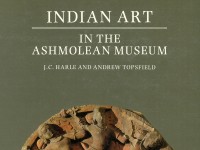Indian Art in the Ashmolean Museum
A catalogue of the Ashmolean’s collection of Indian art by J. C. Harle and Andrew Topsfield (published Oxford, 1987).

Publications online: 143 objects
- Reference URL
Actions
Figure of the saint Tirumankai Alvar
-
Literature notes
The icons of Indian art usually represent gods, demi-gods or creatures of myth. Nonetheless, although to a lesser degree than in the West, images have also been made since at the least the 6th century of holy men, great teachers and especially ardent devotees, particularly in South India. The Museum’s collection includes a seated bronze figure of a Vaiṣṇava teacher (ācārya) perhaps Rāmānuja, the great theologian and philosopher [EAX.2387]. Most commonly represented of all, however, are the Śaiva Nāyanārs [see EA1956.673 and EA1956.674] and the Vaiṣṇava saints called Āḻvārs (7th–10th centuries). Tirumaṅkai Āḻvār, depicted here, is one of the most famous of these Tamil saints and hymnists; reformed bandit or highwayman, he is always depicted holding a sword and a shield. The sectarian mark known as the ūrdhva-puṇḍra engraved on his forehead and the little discus (cakra) and conch-shell on his shoulders leave no doubt as to the Vaiṣṇava affiliation of this image.
Although the legs are rather summarily treated – the shinbones coming to a point in front, in what has been likened to a fish’s roe, facilitating this – the image is not without dignity; and the rear, as so often in South Indian images, is tautly modeled. Small holes in the base are for the insertion of iron rods so that the image can be carried in procession. -
Details
- Associated place
-
Asia › India › south India › Tamil Nadu (place of creation)
- Date
- 15th century (1401 - 1500)
- Associated people
-
saint Tirumankai Alvar (c. 8th – c. 9th century AD) (subject)
- Material and technique
- bronze, solid cast
- Dimensions
- 57.5 x 23 x 21 cm max. (height x width x depth)
- Material index
-
processed material › metal › alloy › copper alloy › bronze
- Technique index
- Object type index
- No. of items
- 1
- Credit line
- Purchased, 1967.
- Accession no.
- EA1967.42
-
Further reading
Harle, J. C., and Andrew Topsfield, Indian Art in the Ashmolean Museum (Oxford: Ashmolean Museum, 1987), no. 67 on pp. 55-56, illus. p. 56
Location
Objects are sometimes moved to a different location. Our object location data is usually updated on a monthly basis. Contact the Jameel Study Centre if you are planning to visit the museum to see a particular object on display, or would like to arrange an appointment to see an object in our reserve collections.
Publications online
-

Indian Art in the Ashmolean Museum
The icons of Indian art usually represent gods, demi-gods or creatures of myth. Nonetheless, although to a lesser degree than in the West, images have also been made since at the least the 6th century of holy men, great teachers and especially ardent devotees, particularly in South India. The Museum’s collection includes a seated bronze figure of a Vaiṣṇava teacher (ācārya) perhaps Rāmānuja, the great theologian and philosopher [EAX.2387]. Most commonly represented of all, however, are the Śaiva Nāyanārs [see EA1956.673 and EA1956.674] and the Vaiṣṇava saints called Āḻvārs (7th–10th centuries). Tirumaṅkai Āḻvār, depicted here, is one of the most famous of these Tamil saints and hymnists; reformed bandit or highwayman, he is always depicted holding a sword and a shield. The sectarian mark known as the ūrdhva-puṇḍra engraved on his forehead and the little discus (cakra) and conch-shell on his shoulders leave no doubt as to the Vaiṣṇava affiliation of this image.
Although the legs are rather summarily treated – the shinbones coming to a point in front, in what has been likened to a fish’s roe, facilitating this – the image is not without dignity; and the rear, as so often in South Indian images, is tautly modeled. Small holes in the base are for the insertion of iron rods so that the image can be carried in procession.
Galleries
Notice
Object information may not accurately reflect the actual contents of the original publication, since our online objects contain current information held in our collections database. Click on 'buy this publication' to purchase printed versions of our online publications, where available, or contact the Jameel Study Centre to arrange access to books on our collections that are now out of print.
© 2013 University of Oxford - Ashmolean Museum






